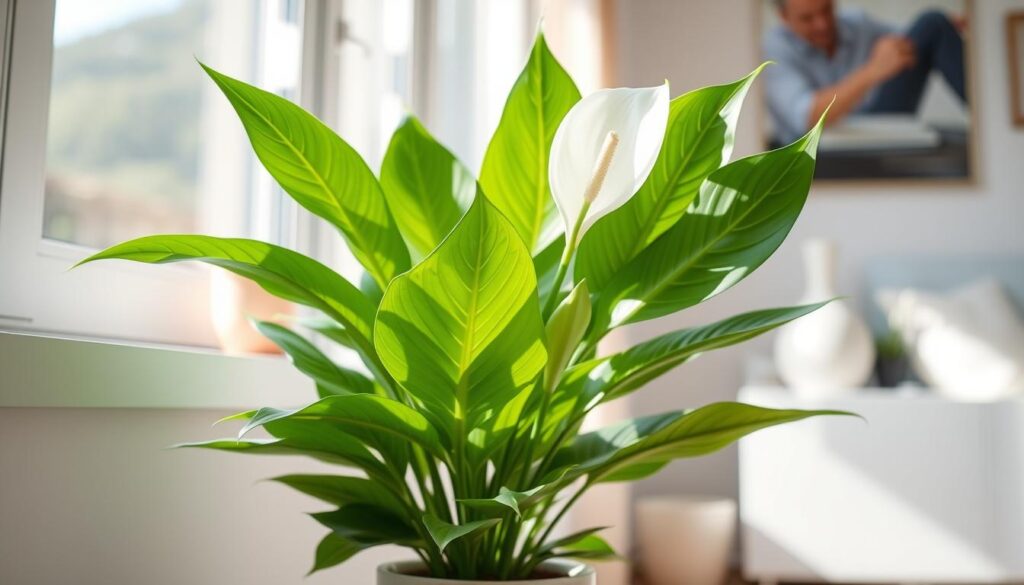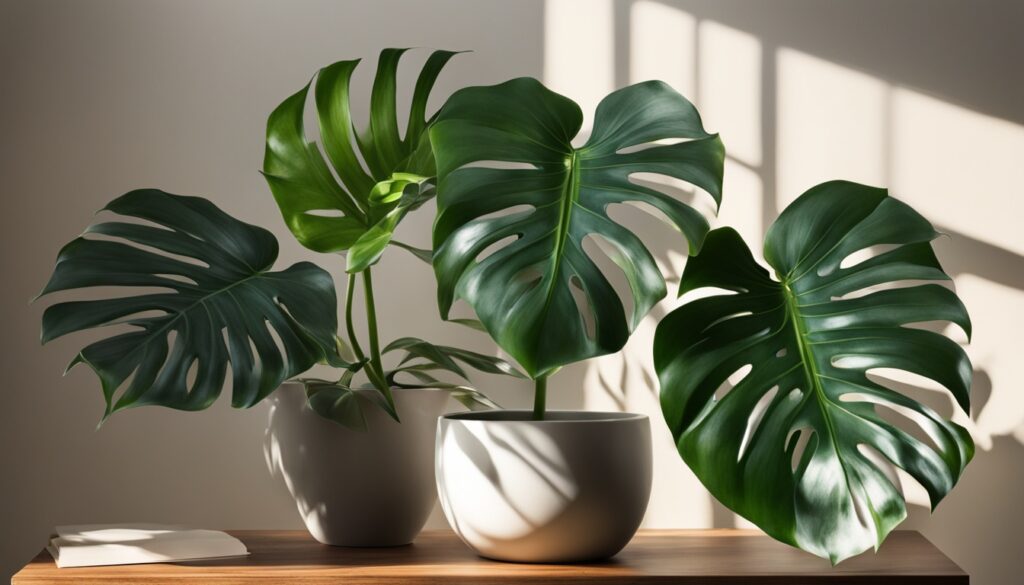Did you know peace lilies can grow up to 16 inches tall? Some outdoor varieties can even reach 6 feet. These plants are not just beautiful but also tough if you care for them right. As a favorite indoor plant, they need a bit of extra love to stay healthy and bloom well.
This guide will show you how to keep your peace lily happy and healthy. We’ll cover everything from where they come from to how to water, light, and care for them. Whether you’re new to plants or have been growing them for years, you’ll learn how to make your peace lily thrive. It will make your home brighter for years to come.
Key Takeaways
- Peace lilies are adaptable indoor plants that can tolerate a range of growing conditions, but proper care is essential for their long-term health and blooming.
- Striking the right balance between lighting, watering, and temperature is crucial for peace lily success.
- Routine maintenance tasks like repotting, pruning, and fertilizing can help peace lilies thrive and reach their full potential.
- Identifying and addressing common peace lily issues, such as browning leaves or lack of flowers, is key to keeping your plant vibrant.
- Safety considerations, including the plant’s mild toxicity, should be taken into account when caring for peace lilies around pets and children.
Understanding Peace Lily Basics
Peace lilies are a favorite indoor plant. They are known for their elegant white blooms and can grow well in many places. These plants come from the rainforest floors of South America. There, they live in rich, moist soil under the shade of taller plants.
Peace Lily Varieties and Sizes
The peace lily family has many varieties. Some are small, like the “Petite” which grows only 10 inches tall. Others, like the “Sensation”, can grow up to 4-6 feet wide and tall. This means gardeners can pick the right peace lily for their space and style.
Basic Growing Requirements
- Thrive in temperatures between 65-85°F
- Require consistently moist, well-draining soil
- Prefer bright, indirect light, although they can tolerate some shade
- Can bloom year-round with proper care and may live for decades indoors
Knowing where peace lilies come from and what they need helps gardeners. This ensures these beautiful plants stay healthy and bloom well for years.
| Peace Lily Variety | Height | Bloom Size |
|---|---|---|
| Petite | 10 inches | 4-6 inches |
| Sensation | 4-6 feet | 12-16 inches |
| Mauna Loa | 2-3 feet | 8-10 inches |
| Domino | 12-18 inches | 6-8 inches |
Essential Light Requirements for Peace Lilies
Understanding the light needs of peace lilies is key to their health. These plants do well in low to moderate light. They’re perfect for places with little sunlight.
Peace lilies can grow with 2-4 hours of indirect sunlight daily. They do best in bright, filtered light. East-facing windows offer the right amount of light for them.
Direct sunlight can harm peace lilies. It causes brown spots, wilting, and slow growth. If your peace lily gets too much sun, move it to a shadier spot. Trim damaged leaves to help it heal.
- Peace lilies thrive in low to moderate bright, filtered light conditions
- They can adapt to various light conditions but prefer bright, indirect sunlight for optimal growth
- Peace lilies should be placed near a north or east-facing window for the best light exposure
Peace lilies also grow well under artificial lights like fluorescent or LED grow lights. Place them to get 10-12 hours of light daily. This ensures they grow well and bloom regularly.
Managing light is vital for peace lilies’ health. It keeps their leaves green and encourages white flowers. By adjusting light levels, gardeners can make their peace lilies thrive indoors.

Proper Watering Techniques and Schedule
Keeping the right moisture balance is key for your peace lily’s health. These plants do best when the top inch of soil is dry. Use room-temperature, filtered water to avoid harming your plant.
Peace lilies need watering when the top inch of soil dries. This can change based on light, temperature, and pot size. Indoor peace lilies need less water than outdoor ones, even in shady spots.
Signs of Improper Watering
Too much water can turn leaves yellow and cause root rot. Not enough water makes peace lilies wilt dramatically. Watch for these signs to water your plant right.
Drainage Requirements
Good drainage stops waterlogged soil and root rot. Pick a pot with holes and use a mix that drains well. This keeps your peace lily’s roots healthy.
| Watering Frequency | Soil Moisture | Visual Signs |
|---|---|---|
| Overwatering | Consistently moist or wet | Yellow leaves, root rot |
| Proper Watering | Top inch of soil dry | Vibrant, upright leaves |
| Underwatering | Completely dry | Dramatic wilting |
https://www.youtube.com/watch?v=Gr-EiOz8AYk
“Peace lilies are dramatic plants that will visibly wilt when thirsty, but they can recover quickly with proper watering.”
Optimal Soil Conditions and Potting Mix
Keeping the right soil conditions is key for your peace lily’s health. These plants love a mix that holds some moisture but also drains well. This prevents too much water and root rot.
Many potting soils on the market might not be perfect for peace lilies. A DIY potting mix lets you tailor the soil to your plant’s needs. Mix orchid bark, coir, perlite, activated charcoal, and worm castings for the best results.
If you’d rather not make your own mix, try the Premium Monstera Potting Soil. It’s made for aroids like peace lilies. It has coco coir, orchid bark, and perlite for great drainage and moisture.
- Use a well-draining, all-purpose potting soil rich in organic matter for peace lily soil.
- Avoid potting mixes designed for succulents, as they dry out too quickly for peace lilies.
- Consider a mix containing peat moss, fine bark, or perlite to provide the right balance of moisture retention and drainage for potting mix for peace lilies.
“The key to a thriving peace lily is finding the perfect balance between moisture and drainage in the soil. With the right potting mix, you can ensure your plant stays healthy and happy for years to come.”
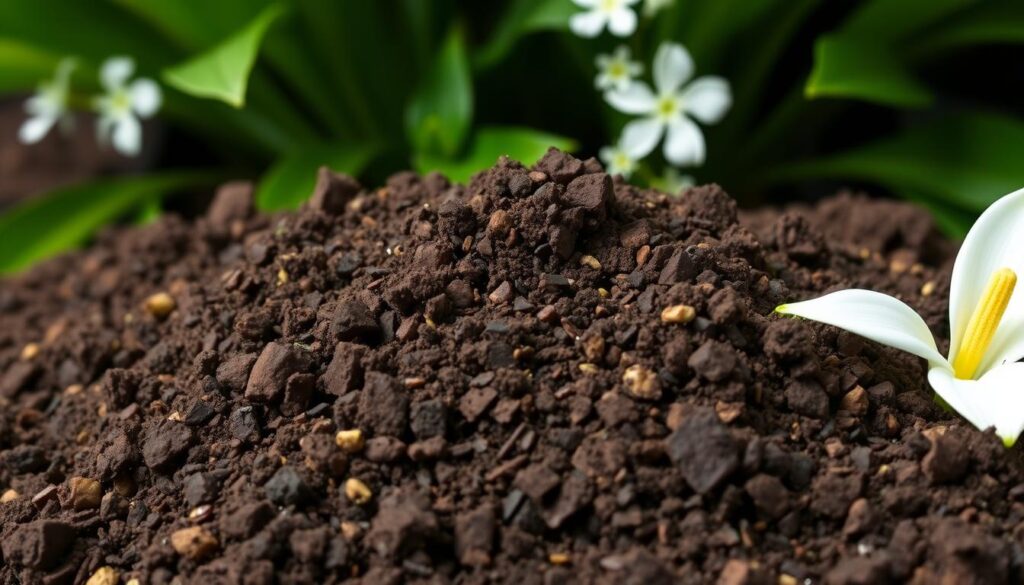
By giving your peace lily the best soil, it will grow well and bloom beautifully. With some care and the right mix, your peace lily will be a beautiful part of your space.
How to Keep Peace Lily Healthy in Different Environments
Keeping peace lilies healthy is a delicate task. They have specific needs for growth, whether indoors or outdoors. It’s important to know the best conditions for your peace lily to thrive.
Indoor Climate Control
Peace lilies do well in most indoor settings. They grow best when the temperature is between 65-85°F [https://amzn.to/3Ut2EQW]. Make sure to keep them away from cold drafts from vents. These drafts can stress the plant and cause browning leaf tips.
Humidity Management
Peace lilies come from tropical areas and need high humidity. You can mist the leaves or put the pot on moistened gravel to increase humidity. Grouping your peace lily with other plants also helps keep the air moist, which is good for its growth.
Temperature Requirements
It’s key to keep the temperature right for peace lilies. They do best in temperatures between 65-85°F [https://amzn.to/3Ut2EQW]. Protect them from cold drafts and sudden temperature changes, as these can harm the plant.
By knowing the peace lily environment and humidity requirements for peace lilies, you can keep your plant healthy and vibrant. With proper care, your peace lily will add lush, tropical beauty to your space.
Feeding and Fertilization Guidelines
Feeding and fertilizing your peace lily is key to its health. These plants are light feeders, needing less fertilizer. Use a balanced peace lily fertilizer at a quarter strength every 6-8 weeks in spring and summer.
For a natural option, try fish emulsion. This peace lily fertilizer can be used every 4-6 weeks. But, avoid too much fertilizer to prevent damage. It’s safer to give less than more.
- Use a balanced 10-10-10 NPK fertilizer to keep peace lilies healthy and encourage vibrant spathes.
- Apply liquid fertilizers every 4-6 weeks during the growing season, following the product’s instructions.
- Slow-release pellets can be applied in early spring and early summer to feed peace lilies for the entire season.
- Replace plant food spikes every 30-60 days for large peace lily specimens during the growing months.
- Always apply fertilizer to moist soil for quick nutrient absorption and to prevent root damage.
“Overfertilizing can lead to brown tips, yellowing leaves, or drooping in peace lilies. It’s better to err on the side of less rather than more.”
Remember, peace lily fertilizer is not a fix for problems. Too much can stress the plant. By following these tips, your peace lily will get the nutrients it needs to grow well and bloom beautifully.
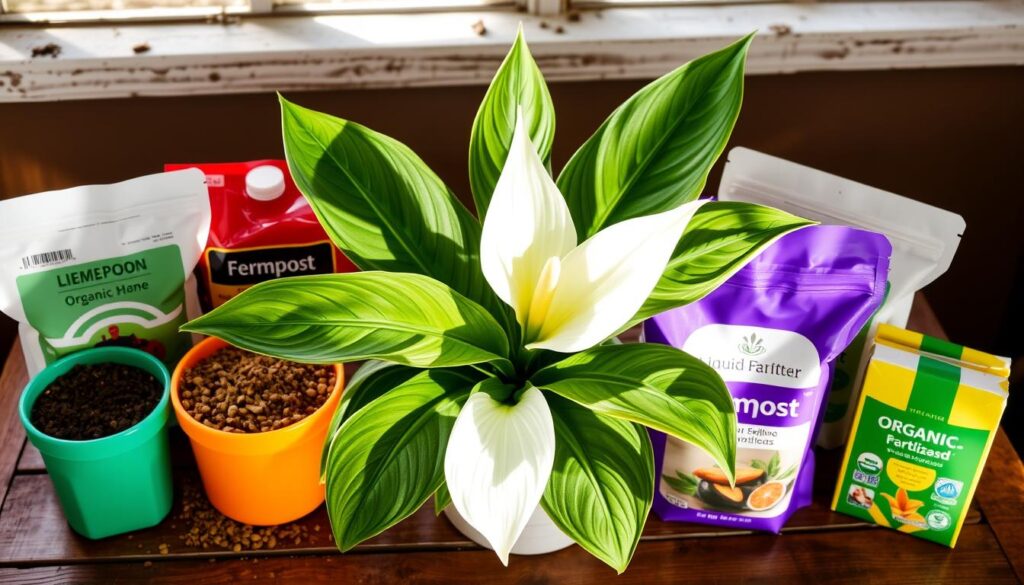
Peace Lily Blooming Care
Keeping your peace lily’s blooms vibrant is key to its health. To get plenty of peace lily flowers, make sure it gets the right light and care.
Encouraging Flower Production
Peace lilies need bright, indirect light for a few hours daily to bloom. If your plant isn’t blooming, it might not have enough light. Check the lighting and move it to a brighter spot if it’s needed.
Also, giving your peace lily enough fertilizer is important. Use a balanced, water-soluble fertilizer at half strength once a month when it’s growing.
Flower Maintenance
- Peace lily flowers start green, turn white, then go back to green before browning.
- Take off spent blooms at the base to help new growth and keep flowers coming.
- If your peace lily’s flowers look weak or stay green, change the plant’s fertilization and light.
“Peace lilies can live for years and flower repeatedly when well taken care of.”
With the right light, water, and nutrients, your peace lily will bloom for years. Regular care and adjustments will keep it thriving and beautiful.
Pruning and Maintenance Practices
To keep your peace lily healthy, you need to prune and maintain it regularly. Peace lily pruning helps remove dead or damaged leaves. This lets the plant grow new leaves. Use sharp scissors or pruning shears to cut leaves at the base.
It’s also important to clean the leaves often. Use a damp cloth to wipe off dust. This keeps the leaves shiny and helps the plant grow well.
Watching your peace lily’s health is key. Look for signs of stress like wilting. Fixing problems quickly keeps your plant happy and healthy.
“Maintaining a healthy peace lily requires a balance of careful pruning, regular cleaning, and attentive monitoring. With the right care, this resilient plant can thrive and bring beauty to any space.”
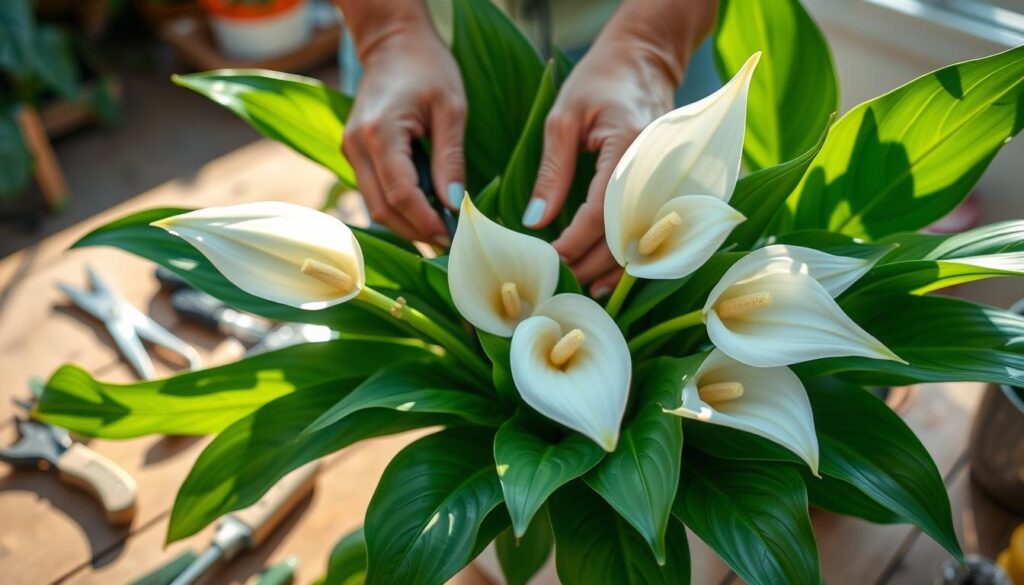
| Maintenance Task | Frequency | Purpose |
|---|---|---|
| Pruning | As Needed | Remove dead, damaged, or yellowing leaves |
| Leaf Cleaning | Periodic | Maintain glossy foliage and support photosynthesis |
| Monitoring | Ongoing | Address any signs of stress or issues promptly |
By following thesepeace lily pruningand maintenance practices, your plant will stay healthy and beautiful for years.
Repotting Your Peace Lily
As your peace lily grows, it needs a new home every 1-2 years. Repotting a peace lily gives it fresh soil and room to grow. It also helps it get the nutrients it needs to stay healthy.
When to Repot
The best time to repot your peace lily is in the spring or early summer. Look for signs like visible roots, soil that’s too dry, and slow growth. If you see these, it’s time to repot your plant.
Proper Potting Techniques
- Choose a pot that’s 1-2 inches bigger than the current one. This gives your plant room to grow.
- Use a potting mix that drains well. Look for mixes with peat moss, perlite, and compost.
- When moving your plant, gently loosen the roots. Then, put it in the new pot.
- Water well after repotting. Place the plant in a shaded area for a few days to help it adjust.
By using these proper repotting techniques, your peace lily will keep thriving. It will have beautiful leaves and flowers for years.
“Repotting a peace lily is essential for its long-term health and growth. By providing fresh soil and adequate space, you can rejuvenate your plant and enjoy its stunning flowers for seasons to come.”
Common Peace Lily Problems and Solutions
Keeping a peace lily healthy needs careful attention. These plants are generally easy to care for but can face some common issues. Knowing the signs and solutions helps your peace lily stay healthy for years.
Overwatering is a big problem for peace lily owners. It can cause yellow leaves, wilting, and root rot. Underwatering, on the other hand, leads to dry, brown tips and droopy leaves. Check the soil moisture often and adjust your watering.
Peace lilies also need the right light. They do best in indirect, bright light but can get damaged by direct sunlight. Make sure they get the light they need to grow well.
- Adjust watering practices to prevent over- or under-watering
- Provide the right amount of indirect, bright light to avoid leaf damage
- Monitor soil quality and ensure proper drainage to prevent compaction and nutrient imbalances
Pests and diseases can harm peace lilies too. Watch for spider mites and scale insects, which can cause webbing and sticky leaves. Use neem oil or insecticidal soap to treat these pests. Also, look out for fungal or bacterial infections and treat them with fungicides.
“Preventive care is key to maintaining healthy peace lilies. By staying proactive and addressing any issues early on, you can ensure your plant remains vibrant and thriving for years to come.”
Understanding common peace lily problems and fixing them early helps your plant stay healthy. A little care goes a long way in keeping your peace lily thriving.
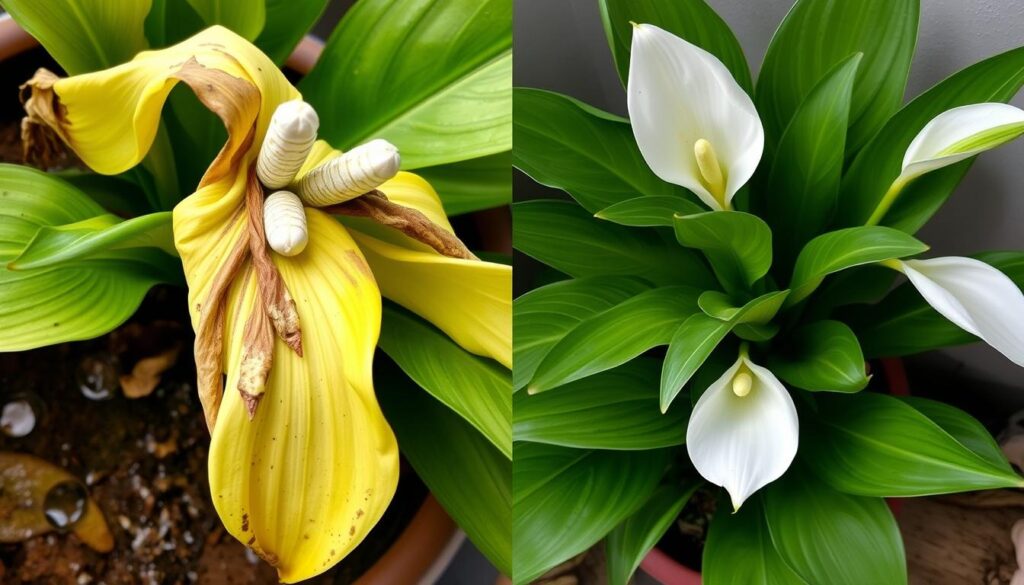
Dealing with Pests and Diseases
Peace lilies are tough plants but can face pests and diseases. Knowing how to spot and fix these problems is key to keeping your peace lily happy and healthy.
Identification of Common Pests
Mealybugs and scale insects are common pests for peace lilies. They suck sap, causing color changes, slow growth, and stress. Look for white, cotton-like spots on leaves and stems for mealybugs. Scale insects are small, hard bumps that can be brown, black, or white.
Treatment Methods
If you think your peace lily has pests, act fast. A solution of insecticidal soap or neem can kill pests. Also, wiping leaves with mild dish soap and water can help keep pests away.
Peace lilies can also get root rot from too much water and bad drainage. Signs include yellow leaves, wilting, and a bad smell. Plant your peace lily in good draining soil and water it right.
By watching for pests and diseases and fixing them quickly, your peace lily will stay healthy. Good growing conditions, like enough light and the right water, also help prevent problems.
Propagation Methods and Tips
To keep your peace lily healthy, you need to know how to propagate it. There are several ways to do this, each with its own benefits and things to consider.
Division: The Preferred Approach
Division is the best way to propagate a peace lily. When you repot the plant, split it into smaller parts. Make sure each part has healthy roots and leaves. Repotting every 1-2 years is a great time to do this and encourage new growth.
Water Propagation
You can also propagate peace lilies in water. Choose a healthy section with roots and put it in a clear glass container with water. Watch the roots grow. Once they’re strong, move the new plant to a potting mix that drains well.
Seed Propagation
Peace lilies can also be grown from seed, though it’s less common. Collect the seeds, plant them in a mix for starting seeds, and keep the soil moist and warm. Once the seedlings grow, slowly get them used to their new home.
No matter how you propagate, make sure the new plants have good soil, balanced fertilizer, and a warm, humid spot with indirect light. Following these tips will help your peace lily grow well and thrive.
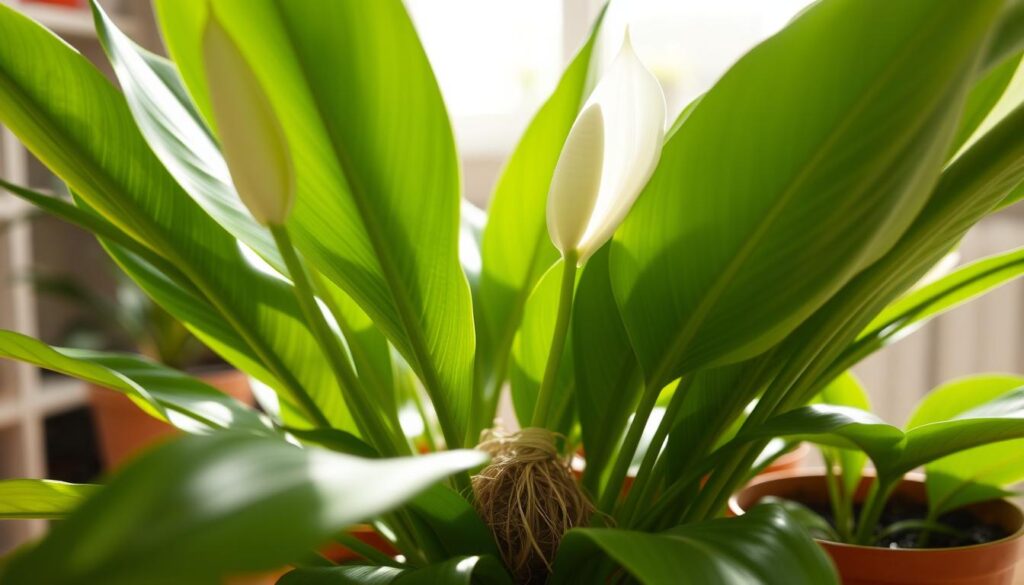
| Propagation Method | Advantages | Considerations |
|---|---|---|
| Division |
|
|
| Water Propagation |
|
|
| Seed Propagation |
|
|
Knowing about the different peace lily propagation methods helps you choose the best way to grow more peace lilies. This ensures their health and beauty for a long time.
Seasonal Care Adjustments
Caring for your peace lily means making changes with the seasons. This ensures it stays healthy and looks great all year. Knowing what your plant needs in each season helps it thrive.
Winter Care for Peace Lilies
In winter, peace lilies grow slower. They need less water and no fertilizer. Water them once a week, but don’t overdo it to prevent root rot.
Keep the temperature between 65°F and 80°F (18°C to 27°C). Also, make sure the air is not too dry by increasing humidity.
Spring and Summer Care
When it gets warmer, water your peace lily more often. Start fertilizing every month with a balanced fertilizer. But, use it at half strength.
Peace lilies love bright, indirect light. But, protect them from too much sun in the summer.
Adjusting water, temperature, and light is crucial for your peace lily’s health. By understanding its changing needs, you can give it the best care. This way, you’ll enjoy its beauty all year round.
| Season | Watering | Fertilization | Temperature | Humidity |
|---|---|---|---|---|
| Winter | Reduced frequency | None | 65°F – 80°F | Increase if dry |
| Spring/Summer | Increased frequency | Monthly, diluted | 65°F – 80°F | Maintain higher levels |
Safety Considerations and Toxicity
Peace lilies are popular in homes, but they can be dangerous. They have sharp, burning crystals that can hurt the mouth, throat, and skin. Children and pets are often affected because they are curious and small.
If someone touches or eats a peace lily, act fast. Rinse the mouth and wash the skin if needed. Keep the plant away from kids and pets and wear gloves when handling it. This can prevent irritation and breathing problems.
Pet Safety Measures
People with pets need to watch out for peace lilies. The plant’s parts have tiny crystals that can hurt pets. This can cause mouth and throat pain, swelling, coughing, nausea, and vomiting.
Child Safety Precautions
Children are also at risk from peace lily toxicity. Most small accidents can be handled at home. But, call Poison Control at 1-800-222-1222 if you think a child has been exposed. Even though it might hurt a bit, serious problems are rare.
To keep pets and kids safe, talk to an expert. They can help find and remove dangerous plants from your home.

Conclusion
Maintaining a healthy peace lily means finding the right balance of light, water, and nutrients. With the right peace lily care, these plants can live indoors for years. They bring lush foliage and elegant white blooms.
Regular checks and care adjustments keep your peace lily beautiful and long-lasting. It becomes a stunning part of your indoor plants.
Knowing what peace lilies need is key. They prefer certain temperatures, humidity, and watering schedules. The right soil, fertilization, and pruning also help them grow well.
With the right care and attention, your peace lily will keep giving you beautiful foliage and blooms. It will also purify the air and add beauty to your home. Follow the tips in this article to grow a thriving peace lily.
